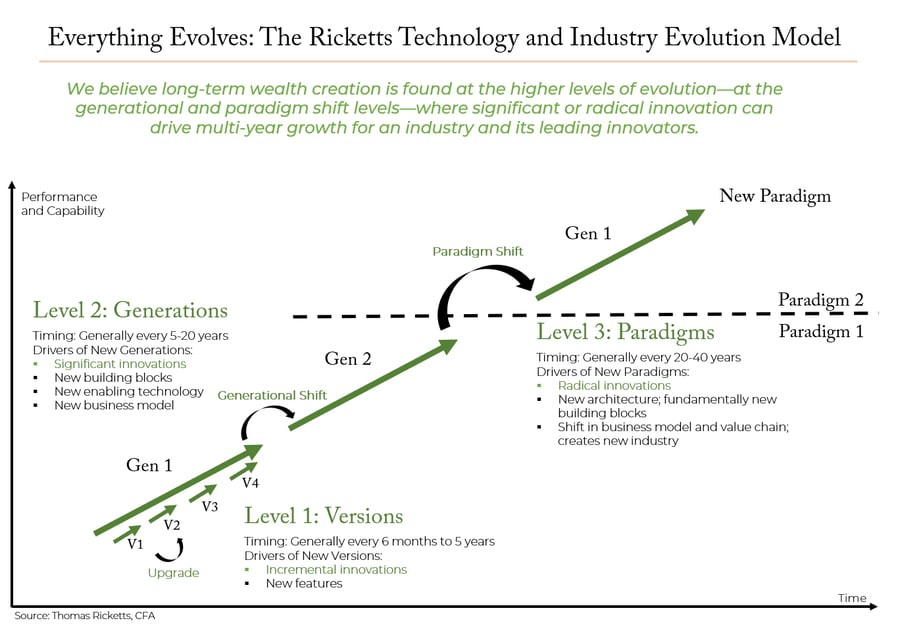In an economy increasingly impacted by innovation, technological change, and evolutionary shifts, industries are facing more periods of dis-equilibrium or disruption relative to periods of equilibrium or stability than in the past. And, in the process more and more industries are being transformed.
Interested in viewing this article as a video presentation (8 min)? Click here.
Importance of Evolutionary Economics and Technical Change to Long-term Investors
From the perspective of long-term investors, techno-evolutionary processes are the primary drivers of industry change, and this applies to both simple and complex products and services. To be clear, we define “technology” in broad terms, including the development of practical knowledge or new concepts, new techniques or designs, and new business models. Technology is embedded in new business model designs and combinations of building blocks that come to life in next-gen product and service offerings. Technology runs deep and wide, and this technical change is a profound force, especially as it evolves over time.
While these evolutionary processes may have been slower in the past, leaving longer periods of stability and obscuring their underlying importance and dynamics, this is no longer the case. Faster innovation cycles, the integration of rapidly-evolving software and intelligence into more products and services (the digitization process), and their attendant disruption are impacting more and more industries. As a result, investors must elevate understanding—and navigating—innovation as a major force impacting their investments.
A New Model for the Evolution of Technology, Products, and Services: Evolution Model
Technology development can be thought of as progressing through three basic levels of hierarchy, with versions at the bottom, generations in the middle, and paradigms at the top (see diagram). Each has a different timescale and relative strength of impact of the underlying innovation.
At the lowest level are versions. A version is simply a new iteration of the technology or offering, and usually only adds one or a few new incremental innovations to the prior version (e.g. think iPhone 6 versus 5). Most new products you see are usually just new iterations, or incremental new versions. From a timing point of view, new versions are typically released every 6 months to 5 years, depending on the industry. A new version is called an upgrade. This is the lowest level of the basic model of evolution, and one that most investors tend to focus on. However, the real power for sustainable profit growth comes from riding the higher levels of the tech evolution model, at the generation and paradigm levels.
At the next level in the hierarchy are technology generations. Technology generations typically last from 5-20 years, depending on the underlying technologies involved. Each generation progresses through a series of versions that add incremental innovations. With, however, enough incremental innovation plus a more substantial innovation or new building block, we begin to mark the shift to a new generation (e.g., shifting from 2G to 3G cell phone technology). It usually takes significant innovation and/or cumulative innovation of prior versions to mark a shift from one generation to another. For the investor, the multi-year adoption cycle of a new generation can drive significant investment returns, particularly if a leading company is able to capitalize on this generational shift.
At the highest level of technology evolution is the paradigm. The concept of the paradigm shift comes from Thomas Kuhn in his seminal book written in 1962, The Structure of Scientific Revolutions, where he described how scientific fields advance through paradigms. He believed that paradigms are organizing frameworks that best describe a field at a point in time, and that a change to a new paradigm happens when a radically new organizing framework demonstrates better explanatory power, displacing the old paradigm, thus creating a paradigm shift.
This paradigm concept has been applied to technology and is best thought of as comprising the fundamental building blocks and core architecture of a given state of technology. A key point is that a shift to a new technology paradigm marks a discontinuous technological change. Discontinuous means a wholesale change from one architecture to a radically different and new one, where new building blocks within a new architecture serve the function of the prior paradigm. These are often called radical innovations. For example, the shift from the Sony + Kodak picture-taking paradigm to the iPhone + Instagram paradigm for taking pictures makes this dynamic clear. Paradigm shifts typically happen every 20-40 years, and are therefore much less common than new generations, which are, in turn, less common than new versions. The key is that the power of wealth creation is tied to new generations and paradigms—driven by generational and paradigm shifts that disrupt the old and usher in the new.
Because most investors tend to focus on the short-term, they, by default, are focusing at the version level, on single incremental innovations of lower importance to long-term wealth creation. We believe long-term wealth creation is found at the higher levels of evolution—at the generational and paradigm shift levels—where significant or radical innovation can drive multi-year growth for an industry and its leading innovators.
Intrigued? We encourage you to watch this eight-minute video segment featuring Evolutionary Tree CIO and Portfolio Manager Thomas Ricketts. In the video, he explains this model and framework for understanding how technologies and industries evolve, and walks through a few examples to bring it alive.
NOTE: In May 2020, we hosted a webinar with the CFA Institute of Columbus, Innovation Investing: Navigating Accelerating Change in an Evolving Economy. The above video is an excerpt of this larger presentation. If you are interested in viewing the full-length (55 min) video presentation please click on the webinar graphic below.



![[Watch Webinar] Innovation Investing: Navigating Accelerating Change in an Evolving Economy (recorded May 5, 2020)](https://no-cache.hubspot.com/cta/default/4802837/a2aaf374-0acb-427d-b82c-f90a60543de2.png)
